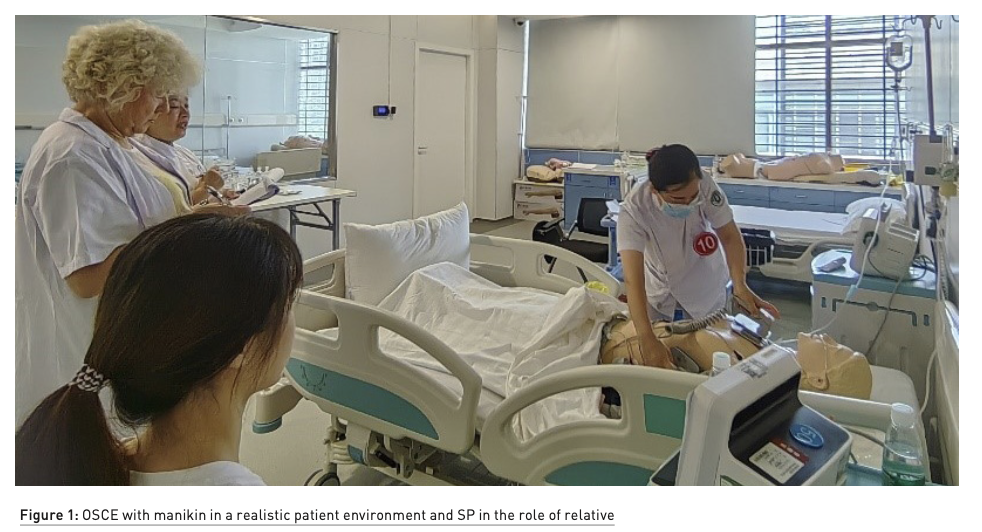HealthManagement, Volume 23 - Issue 5, 2023
This article explores whether simulation could be a valuable tool for addressing the shortage of nurses in the healthcare sector and how it can provide realistic and safe learning environments for nursing students and professionals to practice their skills, gain confidence, and receive feedback.
Key points
- Simulation-based learning is a pedagogical approach that allows students to practice work-related skills in a safe setting and to gain confidence in their performance.
- It involves careful planning, selection and design of realistic scenarios and feedback mechanisms.
- It is not a replacement for traditional instruction but a complementary tool that can enhance learning outcomes.
- Simulation-based learning does not primarily depend on the level of realism or fidelity of the simulation but on the alignment of the learning objectives and the simulation design.
- It also requires a shift from teacher-centred to learner-centred education, where the teacher acts as a facilitator rather than a transmitter of knowledge.
- Simulation-based learning is a relatively new field in nursing education, but it has great potential to improve the quality of nursing care and to motivate and accelerate the learning process of new staff.
- It can also empower patients and their relatives to cope better with their health conditions.
Is There a Way to Improve Nursing Outcomes and Reduce Nursing Staff Shortages?
Nursing in Germany and Europe faces major challenges. The demand for qualified nursing care is steadily increasing as the population ages, and more and more people suffer from chronic diseases. At the same time, the length of stay of patients in hospitals has decreased, which increases the demands on nursing care. Professional nursing care is becoming more complex and requires high professional competence and flexibility. In addition, the diversity of nursing staff in the healthcare system is increasing, which requires intercultural competence and communication.
The rapidly increasing shortage of nursing staff requires different approaches and concepts to reduce the current and future demand with quality assurance. The following three levers can be effective here:
- Recruiting suitable personnel
- Developing technological products to support and assist
- Improving the processes in the healthcare system
Therefore, this article will pursue the following questions: Could simulation be a valuable tool for addressing the shortage of nurses in the healthcare sector? How can simulation provide realistic and safe learning environments for nursing students and professionals where they can practice their skills, gain confidence, and receive feedback?
 t
t
Definition and Types of Simulation
Simulation is a technique that uses realistic scenarios and equipment to mimic the real-world conditions and challenges people face. The kind of simulation or simulator depends on the previously defined goals and competencies the learners should achieve. According to Miller (Framework of Clinical Assessment), the learning pyramid is used for this purpose- the higher the desired level of competence, the more realistic it should be (Waxman 2010).
Low-Fidelity Simulation
Low-fidelity (Lo-Fi) simulation is used to build knowledge. The simulations in this category will feel the least real to the learner. These can include static models and two-dimensional displays. These can also be task trainers designed for specific tasks or procedures such as IV arms or cardiopulmonary resuscitation manikins.
What is the purpose of low fidelity?
Lo-Fi prototyping is a quick and easy way to translate high-level design concepts into tangible and testable artefacts. The first and most important role of lo-fi prototypes is to check and test functionality rather than the visual appearance of the product.
What are the disadvantages of LoFi?
The downsides of low-fidelity prototypes are that they have limited interactivity, lack realism, are hard to use for user feedback, are sometimes too basic to reflect the user experience of the finished product, and can oversimplify complex issues.
High-Fidelity Simulation
High-fidelity (Hi-Fi) simulation is a healthcare education methodology that involves the use of sophisticated life-like manikins in realistic patient environments (types of simulation). The top used scenarios in Hi-Fi simulations are:
- Hypo and hyperglycaemia
- Deteriorating patient
- Respiratory: distress, arrest, and pulmonary embolism
- End of Life: the dying patient
- Cardiovascular: myocardial infarction and cardiac arrest
- Sepsis and multiple organ dysfunction syndrome
- Fluid volume deficit: electrolyte imbalance of geriatric patients
- Congestive heart failure exacerbation
- Shock: anaphylactic, cardiogenic, neurogenic
Standardised Patients
Standardised patients (SPs) are used for exams like OSCE. They follow strict and uniform guidelines to ensure consistency for trainees. This includes opening statements, answers and emotions (ASPE 2018). For communication training, SPs are more flexible and interactive. They can use their own biography and improvise. They also give feedback to trainees after the training (Schlegel 2015).
AR/VR-Simulation
Augmented reality (AR) adds virtual content to the real world. Users see the virtual elements as part of the real space. AR can also use other senses besides vision. Virtual reality (VR) creates a simulated experience that can be similar or different from reality. VR helps users empathise with others and understand their conditions, such as Alzheimer’s.
Gamified Simulation
A gamified simulation is a learning method that combines elements of games and simulations to increase the motivation, engagement and feedback of the learners. In nursing education, a gamified simulation can help improve the clinical skills, critical thinking and decision-making of the students. A gamified simulation in healthcare can take various forms, such as virtual patients, interactive scenarios or digital games. The key dimensions of educational games are explained in Table 2.

Advantages and Chances of Simulation
Simulation is a technique that mimics real-life scenarios using tools and technologies. It has many benefits and opportunities for nursing and patient education. For example:
- Improved patient safety: to reduce the risk of medical errors and improve patient outcomes.
- Enhanced training: provides healthcare professionals with a safe and controlled environment to practice their skills, gain experience, and improve their confidence and competence.
- Cost-effective: simulation can be a cost-effective way to train healthcare. professionals, as it eliminates the need for expensive equipment and supplies.
- Research opportunities: to be used to research new treatments, procedures, and technologies.
- Improved communication: helps healthcare professionals to improve their communication skills and to improve teamwork and collaboration among healthcare professionals.
Simulation in patient education is another area where it has several advantages. Here are some:
- Improved patient outcomes: helps patients to better understand their medical conditions and treatments.
- Increased patient engagement: helps patients to become more engaged in their own care.
- Reduced anxiety: helps patients to become more familiar with medical procedures and treatments, which can reduce anxiety and stress.
- Improved patient satisfaction: helps patients to feel more confident.

Challenges and Limitations
The cons of HiFi are the acquisition and maintenance costs and the inflexibility to change. Additionally, it is necessary to teach the facilitators and teachers and adapt their qualification profiles. The students often feel overconfident after the HiFi training, which could be an emerging risk in applying into practice.
Examples of Best Practices of Simulation Design
To prepare for simulation training, you need to do a needs analysis, plan the learning objectives and outcomes, design the simulation format and case, and choose the appropriate realism level. The simulation consists of prebriefing, simulation, and debriefing/feedback. The moderator guides the student and evaluates the performance. The student also reflects on their own learning (INACSL Healthcare simulation).
New Roles for Teachers and Mentors
Simulation training needs a skilled teacher/moderator who can facilitate learning, not just give information. The teacher/moderator should be trained in simulation moderation and help the participants reflect on their simulation experience. The teacher/moderator should ask questions in the debriefing, such as:
- Why did you act that way?
- What other options did you have?
- How can you do better next time?
- What difficulties did you encounter?

Enough Theory - Let’s Start with Examples
Recruiting, Onboarding, New Jobs and Reintegration of Healthcare Professionals
Simulation is a useful tool for assessing and improving candidates’ skills, knowledge and attitudes in a standardised way. It also helps them to adapt to new situations by trying different options and outcomes in a safe and fun environment. Simulation enhances learners’ engagement, motivation and confidence and supports team collaboration and communication.
Compliance, Health and Safety Training
Simulation, especially gamified, boosts engagement and results in health and safety training. This topic needs regular instruction, but staff usually show low interest and perform poorly (Corporate eLearning Industry).
Theory/Practical Transfer/Circulation
Compared to traditional education and well-known simulation, there are more tools in gamified simulation that you should have a closer look at. For example, gamification for quizzes and feedback. Rolling out gamified quizzes is a great way to test your employees’ skills and collect feedback through surveys. Also, gamification can create rewards and leaderboards to motivate employees to engage in training. Another very positive way is effective storytelling. Gamification can create engaging stories that help learners better understand and retain information and use them in their daily routines.
Gamified simulation offers helpful tools in addition to traditional education and simulation. For example, you can use gamification for quizzes, feedback, rewards, leaderboards and storytelling. These tools can help you test, motivate and teach your employees effectively.

Education Patient/Relatives
Simulation can educate patients and relatives, increase their motivation, promote interaction and empower them. Many start-ups have created tools for chronic and mental illnesses. For example, VR can treat phobias and post-traumatic stress disorder (PTSD) by exposing patients to fear in controlled doses (HealthCare-Technology).
Conclusion
Simulation can enhance nursing education and practice by offering realistic and safe scenarios. Simulation can improve nursing skills, confidence, feedback, competence, and performance. Simulation can also lower the risk of errors and adverse events, which can harm patient safety and quality of care. Simulation can also promote intercultural competence and communication, which are vital for working in diverse teams and settings. Thus, simulation can support nursing care development in Germany and Europe, address the healthcare system challenges and have a positive effect on reducing the shortage of nursing staff.
Conflict of Interest
None.
References:
Association of Standardized Patients Education [ASPE] (2018) The Global Network for Human Simulation Education. ASPE. Available at https://www.aspeducators.org/about-aspe
Fanning R, Gaba D (2007) The Role of Debriefing in Simulation-Based Learning. Simulation in Healthcare: The Journal of the Society for Simulation in Healthcare. Available at https://pdfs.semanticscholar.org/289b/34d437ccb17fe2543b33ad7243a9be644898.pdf
Gottsegen G (2023) How Virtual Reality in Healthcare Is Changing Medicine. Builtin. Available at https://builtin.com/healthcare-technology/ar-virtual-reality-healthcare
INACSL. Healthcare Simulation Standards of Best Practice™. Available at https://www.inacsl.org/healthcare-simulation-standards
Miller GE (1990) The Assessment of Clinical Skills/Competence/Performance: Academic Medicine. 65(9) Sept Supplement. Available at http://winbev.pbworks.com/f/Assessment.pdf
Munday R (2022) Types of Simulation in Nursing Education. NurseJournal. Available at https://nursejournal.org/resources/types-of-simulation-in-nursing-education/
Schlegel C (2015) Feedback von Simulationspatientinnen und – patienten. Bern: Hep Verlag.
SimNAT Pflege (2018) Simulation in der Pflege. Available at https://simnat-pflege.net/
Tomar SH (2023) Measuring The Effectiveness Of Corporate Learning. eLearning Industry. Available at https://elearningindustry.com/measuring-the-effectiveness-of-corporate-learning
Waxman KT (2010) The development of evidence-based clinical simulation scenarios: guidelines for nurse educators. J Nurs Educ. 49(1):29-35. doi:10.3928/01484834-20090916-07
















